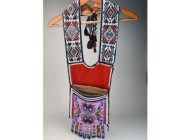
A new record for spurs at auction was made at $236,000 with Ed Bohlin’s spurs from his personal parade ensemble called “The Big Saddle.” The rest of the ensemble is in the Autry Museum of the American West. The elaborate decorations include the use of three golds, rose, yellow and white, and silver and stainless steel. “The Big Saddle” took Bohlin and his artisans more than 14 years to create and the whole is considered one of the finest creations to come out of that revered studio. It was purchased by a private collector bidding in the room.
Review by Greg Smith, Photos Courtesy Brian Lebel’s Old West Events
MESA, ARIZ. – Brian Lebel’s January 22-23 Mesa Old West Auction was a heavy hitter. The sale unloaded 275 lots from the Dick Flood Sr and the Daro Flood Family Collection on the first day, and followed it up with 408 lots in a general session the day after. The auction grossed just over $2 million.
If you close your eyes to the visual masterpieces of Western American history and culture, a Lebel auction can also produce a rich auditory experience. The claps of a rifle, the clops of a hoof, the jingle of a spur. It was the lattermost that proved the loudest in this heat when Edward Bohlin’s personal parade spurs sold for $236,000, a record for American spurs at auction. They were purchased by a determined floor bidder, a private collector. Bohlin, America’s greatest saddlemaker, produced the spurs as part of the “Big Saddle,” a personal parade ensemble that marked the pinnacle of his output. The whole comprised a saddle, bridle, quirt, breast collar, boots, spurs, gunbelt and guns. It took him and his artisans more than 14 years to complete and the rest of it, minus the spurs, is in the collection of the Autry Museum of the American West. A lengthy description from James Nottage, former curator at five museums including the Autry and Eiteljorg and author of Saddlemaker to the Stars: The Leather and Silver Art of Edward H. Bohlin, outlined each minute detail in the spurs – and there were many – and closed with this: “These unique spurs arguably are the finest work of the Bohlin shop. They are of artistic and historic significance that ranks them among the best of spurs created in any shop.” The spurs featured imagery of flower buds, raccoon, cowboy on a bucking bronco, eagle, floral wreaths and an Indian chief in full headdress. Each of those details were overlaid and chased into yellow gold, red gold and sterling silver and sewn onto black leather straps by Angel Diaz.
Though Bohlin claimed to have done every bit of work on the “Big Saddle,” Nottage included a recounting from Diaz that said otherwise. “Leather worker Angel Diaz recalled years later that the staff would go home about 5 pm and that a silver chaser, a mystery man to the other workers, would come in and assist the boss on what was formally becoming known as The Big Saddle. Ed personally did the eagles, Indian heads and many of the other elements. The mystery man did the larger chased sections, including the tops of the tapaderos, the cantle and the brow and nose bands on the bridle… Other workers who contributed to the finished product were George Weber who did silver soldering and fitting; Clarence Smith did the patterns and cut the leather components; Lee Ferris fit the metal elements to the leather and built the display stand and case; Gabriel Diaz did the leather stamping; and Angel Diaz did the hand sewing with flat silver-wire thread.” Others included Clemens Friedell and Dan Smed.
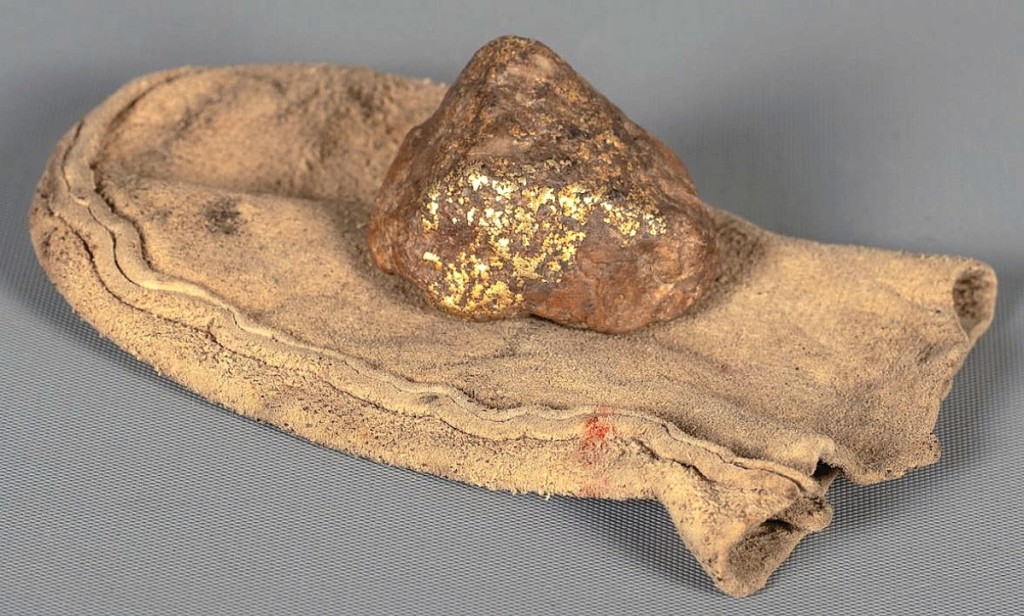
A gold nugget accompanied by a note in Granville Stuart’s hand indicated that it was found on Pioneer Bay in Montana in 1857. It passed from Stuart’s wife to Dick Flood and sold here for $94,400.
“In that category, they were the finest spurs I’ve ever sold,” Lebel said. “When you’re talking about semi-contemporary spurs, things that are not ancient or of historic value, they are definitely the pinnacle of art when it comes to goldsmith or silversmith material.”
It is unknown how the spurs were divided from the rest of Bohlin’s parade suit, but the first record of another person owning them was in 1977 when they were purchased by an attorney and sheriff in Houston, Texas. They were then acquired in 2003 by John Reedy, the then-owner of the Bohlin Company, who then sold them into a California collection. Bohlin was seen wearing the “Big Saddle” in every annual Tournament of Roses Parade from 1947 to 1973, as well as the Santa Barbara Fiesta parade, the Sheriff’s Rodeo in the Los Angeles Coliseum and the Santa Claus Lane Parade in Hollywood. The “Big Saddle” was exhibited in 1967 at the World’s Fair in Montreal.
The spurs were only one of 39 lots in the auction from Bohlin. Others of note included the artist’s personal filigree gold belt buckle, which went out at $47,200. Nottage called it “one of the top four or five Bohlin belt buckles ever manufactured,” its composition in varied colored golds – rose, yellow and white – matched in quality with the imagery of pronghorn antelope, rainbow trout, bull moose, bull elk, bighorn sheep, grizzly bear and trophy deer. According to a 2004 document, Bohlin took the belt from around his waist and gave it to Donald W. Douglas Jr, the president of Douglas Aircraft, who owned a ranch near Yerington, Nev., in the 1950s or 1960s. Finishing at $23,600 was a 1940s “Ward” model Bohlin parade saddle with sterling silver adornments. At $7,865 was a fine Bohlin hand-tooled leather briefcase that once belonged to Larry Hagman, who paid around $6,000 for it new in the 1980s.
There were a number of other spurs and saddles from varied makers that deserve mention. Selling for $10,620 was a pair of fully mounted 1900s double “horseshoe” pattern spurs by J. Tapia, a Los Angeles maker comprised of father Jose and son Jesus. The spurs featured the J. Tapia mark, in itself rare, and included stylistic teardrops and heelchains. Also with Tapia-style heelchains was a pair of California silver inlaid cowgirl spurs, circa 1910, that went out at $7,670. From the Keyston Bros company based in San Francisco came a $23,600 result for a matching set of two “Jade” mounted sterling silver parade saddles. Into the bridle was a jade cabochon, the auction house noting, “This unique and remarkable set of saddles is only the second we have ever encountered mounted with jade, a symbol of nobility and wealth and revered for centuries as the ’emperors stone.'” A miniature half-scale silver parade saddle with gun belt and holsters by contemporary maker Tad Mizwa (1927-2019) would sell even higher, taking $29,500. Mizwa’s reputation as the “Leonardo of leather carvers” was on show with the masterful work on the set, circa 1990.
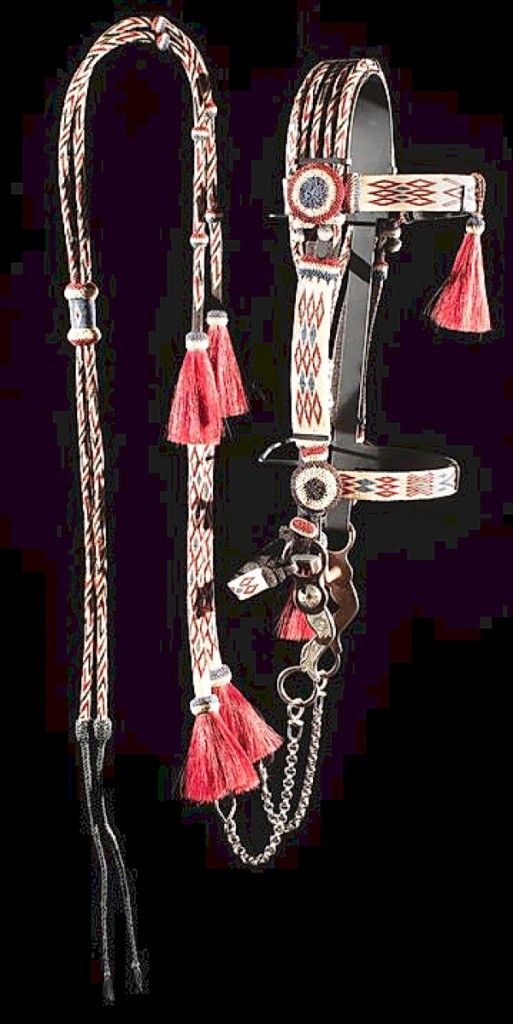
Infamous Canon City prisoner Bob Baldwin, who suffocated his own 6-month-old child, created this horsehair bridle while serving his time. He eventually escaped and was never heard of again. The bridle went out at $12,100.
Prisoner-made bridles always find allure, if not for their beauty than for the notorious hand that made them. From Bob Baldwin, prisoner #9647 at the Colorado State Penitentiary in Canon City, came a horsehair bridle that was presented to that prison’s warden, Boon Best, upon his retirement. Baldwin, who was born into a family of criminals, served two stints in Canon City, the first for burglary and the second for the murder of his 6-month-old son. He escaped during his second tenure and was never found. Selling for $10,890 was a “Good Luck” horsehair bridle by a prisoner at the Montana State Prison in Deer Lodge. A roundel included a nicely rendered portrait of a dog. Selling just under that at $9,440 was a patriotic “Flag” bridle that came from the same prison.
“Dick Flood was one of the leaders and power players in the Western Art world for many years with Trailside Galleries, which is still to this day one of the top galleries in Western Art in the country,” Lebel said. “Dick knew everyone and traveled the circles of Western Art for many years. He brought his son Daro into the business and taught him everything.”
When Flood established Trailside Galleries in Jackson, Wyo., at the foothills of the Grand Tetons, he was the only gallery in town. His roster came to include many notable Western artists, including many award-winning members of the Cowboy Artists of America.
One-hundred-and-two lots relating to artist Joe De Yong were included in the Flood sale on the first day.
“Flood and De Yong became close friends,” Lebel recounted, “Flood was a huge supporter. And Joe was powerful in the art world, knowing everyone form Santa Fe to Santa Barbara and around the world. Dick took him in as a close friend and when Joe died, he left his entire estate to the Floods.”
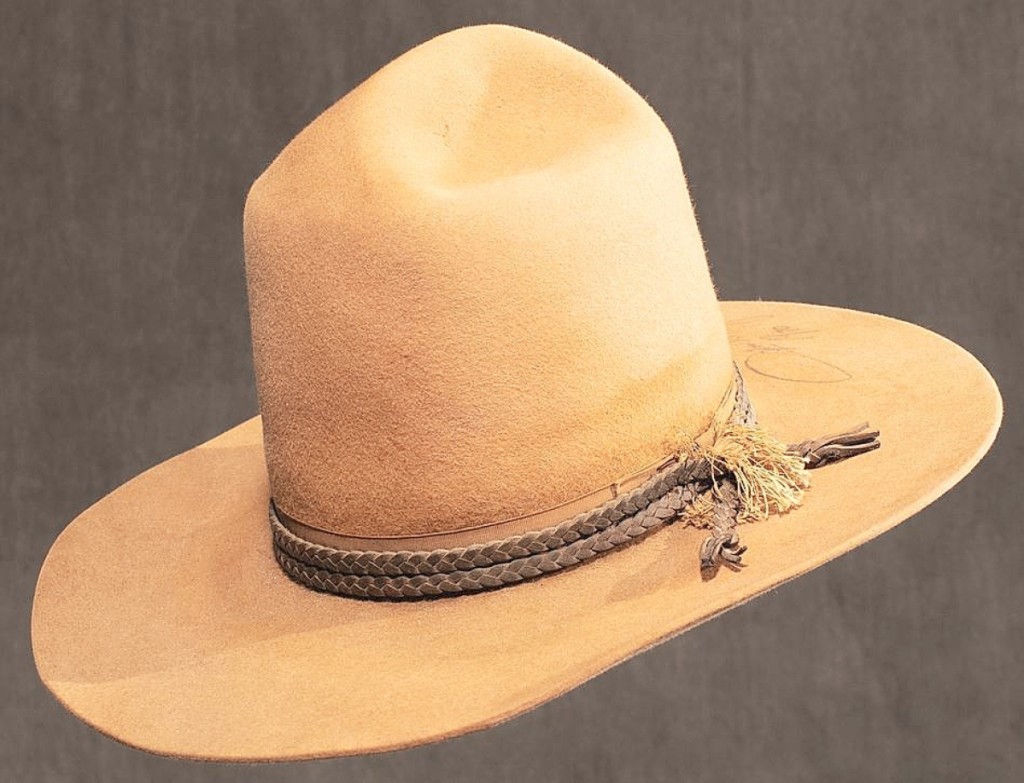
The hat that John Wayne wore in Undefeated would sell for $53,100. The catalog noted that Wayne liked it so much he often wore it offscreen. He eventually gifted the hat to Robert Shelton, founder of Old Tucson Studios, while filming Rio Lobo.
Interest in De Yong’s material was far and wide, but Lebel noted that there was significant activity from museums.
Joe De Yong was a linchpin between the old and new Western Art. “He was a conduit from Charlie Russell all the way up to the Cowboy Artists of America. He brought the whole Western Art world together and that meant a lot to museums,” Lebel said.
De Yong plied his art alongside Russell, Edward Borein and Maynard Dixon, while working in Hollywood as a costume designer and historical consultant on a number of films. Selling for $59,000 was the artist’s archive that numbered in the thousands of pages.
“That lot was very significant,” Lebel said. “Joe wrote everything down and somebody said he never had a thought in his head that he didn’t put on paper. Between all of his personal notes and letters, it also encompassed other artists, how to work with art and sell art, and people he knew, wealthy people or cowboys. It told a huge story about what life was like in Santa Barbara and Montana in the 1930s, a true story of the West.”
De Yong’s photo archive would fetch $22,420. The hundreds of subjects included a snapshot of Western life, including images of Wyoming, Montana, Santa Barbara and Mexico. Also included were images of Ed Borein, Charlie Russell and other artists in his circle. The auction house said the photographs captured “him at his most private and most public.” Also in a group lot was his sketch file box filled with hundreds of original sketches, studies, notes and drawings. It sold for $11,210. Many of his artworks, sold in single lots, brought south of $1,000, while the more notable brought anywhere in the mid-four figures. At $6,050 was a set of five “Tecolite Ranch” etchings, along with the copper plate. For the pure collector was a collection of the artist’s childhood drawings, which sold for $944.
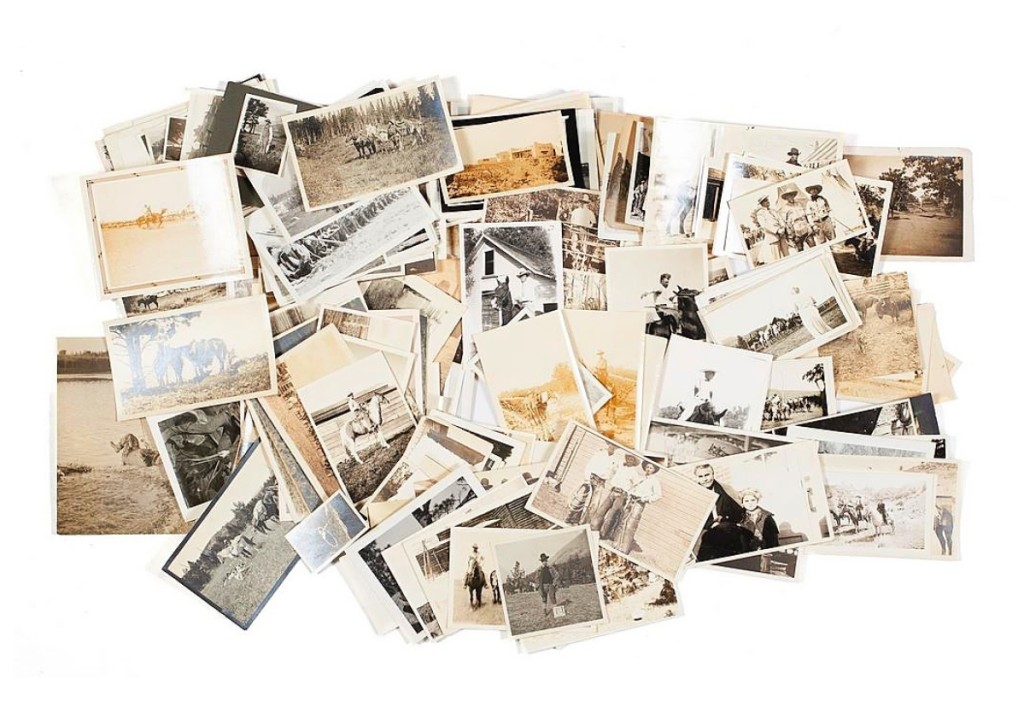
An archive of photographs from the Joe De Yong estate included a trove of images documenting his life and trips. The photographic archive had deep interest from institutions and the whole went out at $22,420.
Dick Flood was a chronicler of artists as he collected things that, at the time, may have seemed mundane, but have grown alongside those artist’s reputations, into artifacts. At $94,400 was a gold nugget including a note in Granville Stuart’s hand that read “Nugget found on Pioneer Bar, Mont., in 1857 near Gold Creek.” The nugget had passed to flood from Stuart’s wife, Mary Stuart Abbott. On the subject of wives, Flood also procured the cookbook of Charlie Russell’s wife, Nancy, along with a lock of her hair, a celluloid compact and her last will and testament. That lot brought $2,360. For a number of winters, Thomas Hart Benton traveled down to Arizona where he worked in the studio of artist Ted DeGrazia. Found in Flood’s collection was a sign that read “Tom Benton,” which hung over Benton’s workspace, as well as DeGrazia’s own sign depicting a landscape, which hung over his. The lot, given to Flood by DeGrazia, sold for $708.
“We did so well in Santa Fe with celebrity hats that a lot of consignors came out of the woodwork – and they were very strong again,” Lebel said. There were 50 lots of hats included in this sale, ranging in owners from artists Edward Bohlin, Maynard Dixon, Charlie Russell, De Yong and Oscar Berninghaus to actors Tom Mix, John Wayne and Dean Martin. The artist hats largely came from Flood. A “Penny’s Marathon” hat illustrated by Joe De Yong for Rancheros Visitadores sold for $5,015, Berninghaus’ Dobbs Rancher took $590, Russell’s classic Stetson brought $18,880, Bohlin’s faded illustrated hat caught $1,089 and Dixon’s Carlsbad Velour hat went out at $1,888. Worn by John Wayne on and off the silver screen was the highest grossing example in the sale at $53,100. Wayne wore it in Undefeated, but it was also his daily driver that he was pictured wearing in numerous photographs. He ultimately gifted the hat to Robert Shelton, founder of Old Tucson Studios, while filming Rio Lobo. Made for Dean Martin was a black Stetson by Nudie’s Rodeo Tailor of North Hollywood that sold for $5,015. A Stetson ranch hat with worn ribbon edge owned by Tom Mix would sell for $8,850.
“I think people appreciate the Western movie genre,” Lebel said. “Those weren’t just bought by people who grew up with it, there were younger people bidding. It was strong across generations.”
Lebel’s next event returns to Santa Fe June 24-26. All prices reported include buyer’s premium. For more information, www.oldwestevents.com or 480-779-9378.

































